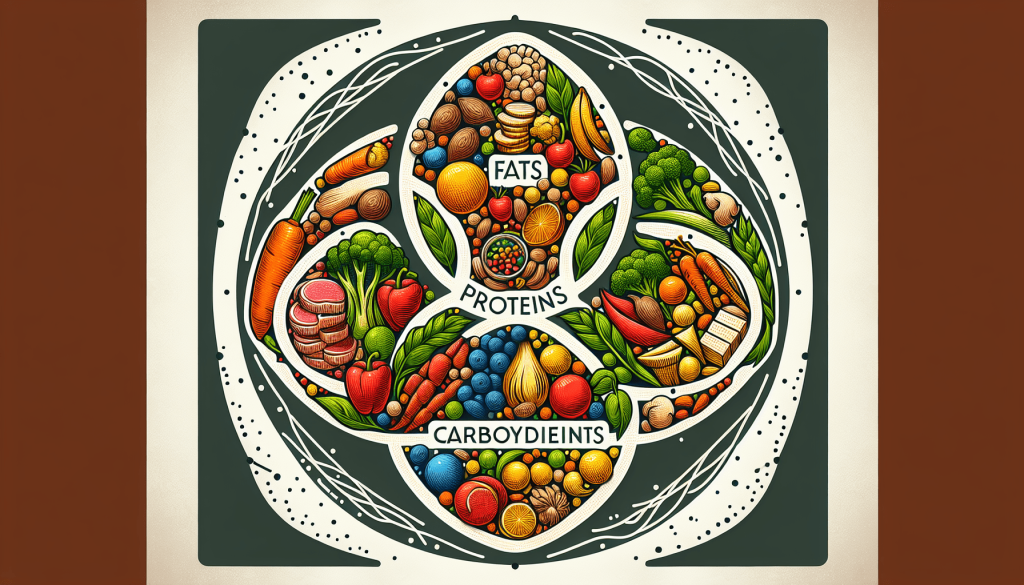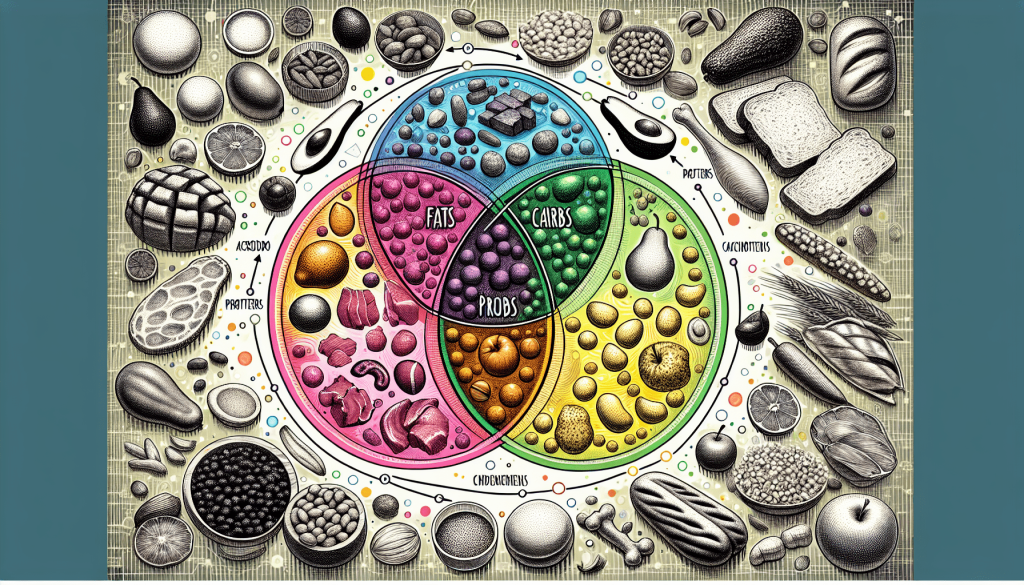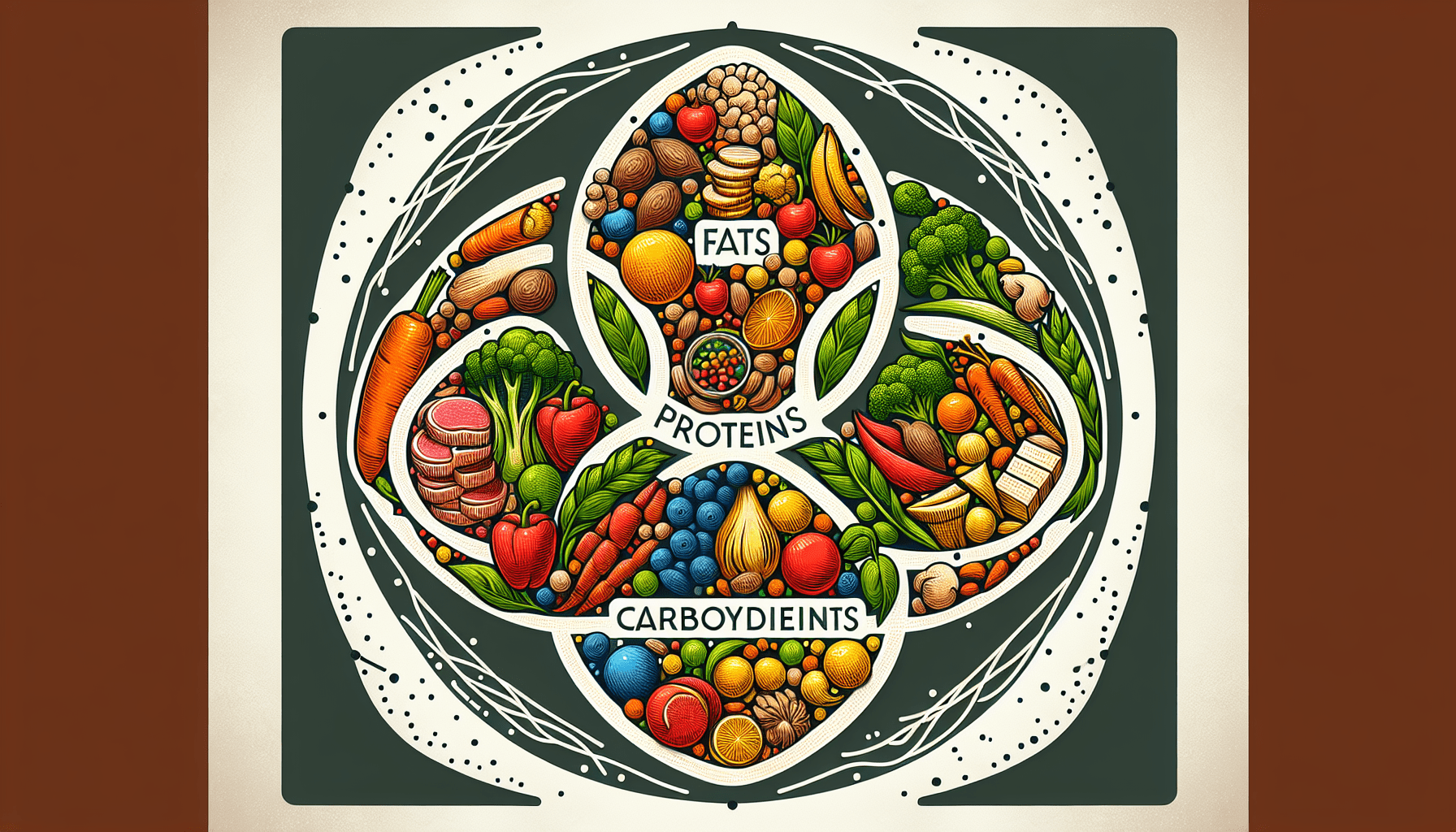Are you looking to embrace a healthier lifestyle but feeling overwhelmed by all the conflicting information out there about fats, proteins, and carbs? Look no further! In this informative article, we will explore the importance of maintaining a balanced approach to macros and delve into the role fats, proteins, and carbs play in our overall health. By the end, you’ll have a clearer understanding of how to make informed choices that support your well-being. So, let’s dive in and discover the key to achieving a healthier, more balanced you!

What are macronutrients?
Macronutrients are the essential nutrients that our body needs in large quantities to function properly. They include fats, proteins, and carbohydrates, all of which play a vital role in supporting our overall health and well-being. While each macronutrient has its own set of functions and benefits, it is important to strike a balance between them to ensure optimal nutrition and maintain a healthy lifestyle.
Definition of macronutrients
Macronutrients are the nutrients that provide energy to our body and are required in relatively large amounts. They are the building blocks of our diet and are responsible for providing us with the necessary fuel to carry out our daily activities. Unlike micronutrients, which are needed in smaller quantities, macronutrients contribute a significant amount of energy to our diet and are essential for maintaining our bodily functions.
Importance of macronutrients
Macronutrients play a crucial role in our overall health and well-being. They provide us with the energy we need to perform physical activities, support the growth and repair of our body tissues, and help regulate various bodily functions. Each macronutrient has its own unique set of functions and benefits, and a balanced intake of macronutrients is essential to maintain good health and promote optimal functioning of our body systems.
Fats
Types of fats
Fats are an essential macronutrient that provides the highest amount of energy per gram compared to proteins and carbohydrates. There are different types of fats, including saturated fats, unsaturated fats (monounsaturated and polyunsaturated fats), and trans fats. Saturated fats are typically solid at room temperature and are commonly found in animal products and some tropical oils. Unsaturated fats, on the other hand, are usually liquid at room temperature and can be found in foods such as avocados, nuts, and seeds. Trans fats are artificially created fats often found in processed foods and have been linked to various health problems.
Functions of fats
Fats serve several important functions in our body. They act as a concentrated source of energy and are necessary for the absorption of fat-soluble vitamins. Fats also provide insulation and protection to our organs, help regulate body temperature, and assist in the production of hormones. Additionally, fats provide a sense of satiety, helping us feel full and satisfied after a meal. It is important to note that not all fats are created equal, and choosing healthy sources of fats is essential for our overall health and well-being.
Recommended intake of fats
The recommended intake of fats varies depending on individual factors such as age, gender, activity level, and overall health. However, as a general guideline, it is recommended that fats should make up around 20-35% of our daily caloric intake. It is important to choose healthy sources of fats, such as avocado, olive oil, nuts, and fatty fish, while limiting the intake of saturated and trans fats.
Effects of excessive fat consumption
While fats are an important part of a healthy diet, excessive consumption of certain types of fats, specifically saturated and trans fats, can have negative effects on our health. These fats have been linked to an increased risk of heart disease, high cholesterol levels, and obesity. It is important to practice moderation and choose healthier sources of fats to maintain a balanced and nutritious diet.
Proteins
Types of proteins
Proteins, like fats, are an essential macronutrient that our body needs for various functions. They are made up of amino acids, which are the building blocks of our body and are involved in the growth, repair, and maintenance of tissues. There are two main types of proteins: complete proteins and incomplete proteins. Complete proteins contain all the essential amino acids that our body needs, while incomplete proteins lack one or more essential amino acids. Sources of complete proteins include animal products like meat, poultry, fish, dairy, and eggs, while plant-based sources like legumes, grains, and nuts provide incomplete proteins.
Roles of proteins in the body
Proteins have a wide range of roles in our body. They play a vital role in the growth and repair of body tissues, including muscles, organs, and skin. Proteins are also involved in the production of enzymes and hormones, which are responsible for various bodily functions. Additionally, proteins play a role in maintaining a healthy immune system and transporting nutrients throughout the body. It is important to include an adequate amount of protein in our diet to support these vital functions.
Recommended protein intake
The recommended protein intake varies depending on individual factors such as age, gender, activity level, and overall health. As a general guideline, it is recommended that protein should make up around 10-35% of our daily caloric intake. However, it is important to note that protein needs may vary for different individuals, such as athletes or those with certain medical conditions. Consulting with a healthcare professional or a registered dietitian can help determine the appropriate protein intake for specific needs.
Consequences of protein deficiency or excess
Protein deficiency can have significant consequences for our health. Insufficient protein intake can lead to muscle loss, impaired wound healing, weakened immune function, and slow growth and development in children. On the other hand, excessive protein consumption can put strain on the kidneys and liver, increase the risk of dehydration, and contribute to long-term health issues. It is important to strike a balance and consume an appropriate amount of protein to support our body’s functions without overdoing it.
Carbohydrates
Different types of carbohydrates
Carbohydrates are another essential macronutrient that is an important source of energy for our body. There are different types of carbohydrates, including simple carbohydrates and complex carbohydrates. Simple carbohydrates are made up of one or two sugar molecules and are quickly digested by the body, providing a rapid energy boost. They can be found in foods such as fruits, honey, and table sugar. Complex carbohydrates, on the other hand, are made up of multiple sugar molecules and are digested more slowly, providing a steady release of energy over a longer period. Examples of complex carbohydrates include whole grains, vegetables, and legumes.
Functions of carbohydrates
Carbohydrates serve as the primary source of energy for our body. They provide fuel for our brain, muscles, and nervous system, enabling us to carry out our daily activities. Carbohydrates also play a role in protein synthesis, support the growth and repair of body tissues, and help regulate our metabolism. Additionally, certain types of carbohydrates, such as dietary fiber, aid in digestion and promote healthy bowel movements.
Recommended carbohydrate intake
The recommended carbohydrate intake varies depending on individual factors such as age, gender, activity level, and overall health. In general, carbohydrates should make up around 45-65% of our daily caloric intake. However, it is important to choose complex carbohydrates over simple carbohydrates, as they provide a steady release of energy and are more nutrient-dense. It is also recommended to focus on whole grains, fruits, vegetables, and legumes as sources of carbohydrates while minimizing the consumption of refined grains and added sugars.
Negative effects of excessive carbohydrate consumption
While carbohydrates are an essential source of energy, excessive consumption of refined carbohydrates and added sugars can have negative effects on our health. These types of carbohydrates can lead to weight gain, increased risk of type 2 diabetes, and chronic diseases like heart disease. It is important to consume carbohydrates in moderation and prioritize nutrient-dense sources to maintain a healthy balance.

Effects of imbalanced macros
Health risks associated with an imbalanced macro intake
Consuming an imbalanced ratio of macronutrients can have various health risks. For example, a diet high in saturated fats and low in carbohydrates and protein can increase the risk of heart disease, obesity, and metabolic disorders. On the other hand, an excessively high protein consumption and a low intake of fats and carbohydrates can strain the kidneys and liver and lead to dehydration. Imbalanced macro intake can also negatively impact blood sugar control, hormonal balance, and overall nutrient adequacy.
Impact on body composition and weight management
The balance of macronutrients in our diet can also affect our body composition and weight management. An imbalance in macros can lead to weight gain or hinder weight loss efforts. For instance, a diet high in carbohydrates and low in fats and protein may contribute to weight gain, while a diet high in protein and low in carbohydrates may support weight loss but may not be sustainable in the long run. Striking a balance between macros is crucial for maintaining a healthy body composition and achieving sustainable weight management goals.
Importance of a balanced macro approach
How a balanced macro approach supports overall health
Adopting a balanced macro approach supports overall health by providing our body with the necessary nutrients it needs to function optimally. Each macronutrient plays a unique role in supporting bodily functions, and a balanced intake ensures that we meet our nutritional needs. Fats, proteins, and carbohydrates all contribute to various physiological functions, including energy production, tissue repair, hormone regulation, and nutrient absorption. By consuming a balanced combination of macros, we can support our body’s needs and promote overall health and well-being.
Optimizing energy levels and physical performance
A balanced macro approach is essential for optimizing energy levels and enhancing physical performance. Carbohydrates, as the primary source of energy, provide the fuel needed for exercise and physical activity. Proteins support muscle repair and growth, helping to maintain muscle mass and improve performance. Fats provide a long-lasting source of energy and contribute to overall satiety. By ensuring an appropriate balance of macronutrients, we can support our body’s energy requirements and enhance our ability to perform physical activities effectively.
Enhancing satiety and maintaining a healthy metabolism
A balanced macro approach can also help enhance satiety and maintain a healthy metabolism. Protein and fat, in particular, have been found to promote feelings of fullness and satisfaction after a meal. By including an adequate amount of protein and healthy fats in our diet, we can prevent excessive snacking and improve portion control. Additionally, a balanced intake of macros helps regulate our metabolism, supporting efficient nutrient absorption, energy utilization, and weight management.
Strategies for balancing macros
Understanding individual needs
One of the first steps in balancing macros is understanding individual needs. Factors such as age, gender, body composition, activity level, and overall health should be taken into account when determining the appropriate macro ratio. Consulting with a registered dietitian or healthcare professional can help assess individual requirements and create a personalized plan.
Building balanced meals
Building balanced meals is another crucial strategy for balancing macros. Incorporating a variety of food groups and macronutrients into each meal ensures that we are providing our body with a well-rounded nutritional profile. A balanced meal typically includes a source of lean protein, healthy fats, complex carbohydrates, and a selection of vegetables or fruits. Experimenting with different recipes and meal combinations can help create balanced and satisfying meals.
Tracking macros and portion control
Tracking macros and practicing portion control can be an effective strategy for balancing macros. Using a food diary or a mobile app, you can track your daily intake of fats, proteins, and carbohydrates to ensure that you are meeting your respective goals. Portion control is also important, as it helps prevent excessive calorie intake and promotes a more balanced distribution of macros throughout the day.
Striking a balance with mindful eating
In addition to tracking macros, practicing mindful eating can also help strike a balance. Mindful eating involves being fully present and aware of our food choices, eating slowly, and paying attention to hunger and fullness cues. By honoring our body’s natural signals and eating in a more mindful way, we can develop a healthier relationship with food and make informed choices that align with our macro goals.
Personalizing macros for different goals
Macros for weight loss
When it comes to weight loss, personalized macros can help create an effective plan. A moderate protein intake can help preserve muscle mass and support metabolism while creating a calorie deficit for weight loss. It is typically recommended to include a slightly higher proportion of protein in the diet, along with a balanced intake of fats and carbohydrates. However, it is important to consult with a registered dietitian or healthcare professional to determine the appropriate macro ratio and calorie intake for weight loss goals.
Macros for muscle gain
For individuals looking to build and maintain muscle, a higher protein intake is often recommended. Protein plays a vital role in muscle repair and growth, and consuming an adequate amount is crucial for muscle development. It is also important to include a sufficient amount of carbohydrates for energy and support recovery. Again, personalized macros should be determined based on individual factors and goals, and consulting with a healthcare professional is advised.
Macros for maintenance and overall health
For individuals looking to maintain their weight and support overall health, a balanced macro approach is key. The recommended macronutrient distribution for maintenance may vary based on individual factors, but a balanced intake of fats, proteins, and carbohydrates can support overall health and well-being. A personalized plan can help ensure that macros are balanced for individual needs and goals, promoting optimal health.
Considerations for specific dietary preferences
Macros on a vegetarian or vegan diet
Individuals following a vegetarian or vegan diet can still achieve a balanced macro intake. Plant-based sources of protein such as legumes, tofu, tempeh, quinoa, and seitan can provide the necessary protein. Nuts, seeds, avocados, and plant-based oils can be sources of healthy fats. Carbohydrates can be obtained from whole grains, fruits, and vegetables. It may be important for individuals following these dietary preferences to carefully plan their meals to ensure they are meeting their specific macronutrient needs.
Macros on a ketogenic diet
The ketogenic diet is a low-carbohydrate, high-fat diet that aims to switch the body into a state of ketosis, where it primarily uses fats for fuel. This diet typically includes a moderate protein intake. On a ketogenic diet, individuals restrict carbohydrates to a very low amount, typically below 50 grams per day, and consume a higher proportion of fats. This allows the body to produce ketones as an alternative source of energy. Following a ketogenic diet requires careful planning and monitoring to ensure adequate nutrient intake and individual adaptations.
Macros on a gluten-free diet
For individuals following a gluten-free diet, it is still possible to achieve balanced macros. Many gluten-free grains, such as quinoa, rice, millet, and amaranth, can provide carbohydrates. Lean proteins, including poultry, fish, eggs, legumes, and tofu, can contribute to protein intake. Healthy fats can be obtained from sources such as avocados, nuts, seeds, and oils. While navigating a gluten-free diet, it is important to read food labels and choose nutrient-dense, naturally gluten-free foods.
Conclusion
In conclusion, understanding macronutrients and striking a balance between fats, proteins, and carbohydrates is key to maintaining optimal health and well-being. Each macronutrient serves unique functions in our body and contributes to various bodily processes. A balanced macro approach supports not only energy production and physical performance but also satiety, metabolism, and overall health. By understanding individual needs, building balanced meals, tracking macros, and practicing mindful eating, we can achieve a balanced macro intake. Personalizing macros for different goals and considering specific dietary preferences ensures that we meet our nutritional needs while aligning with our individual lifestyles. Adopting a balanced approach to macros ultimately supports our overall health and helps us achieve a sustainable and nutritious diet.
